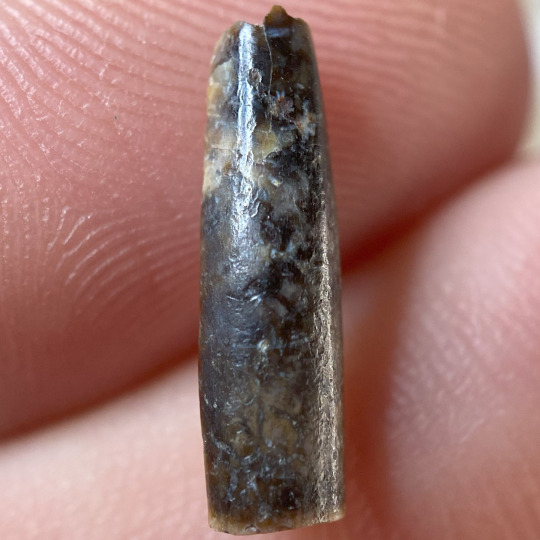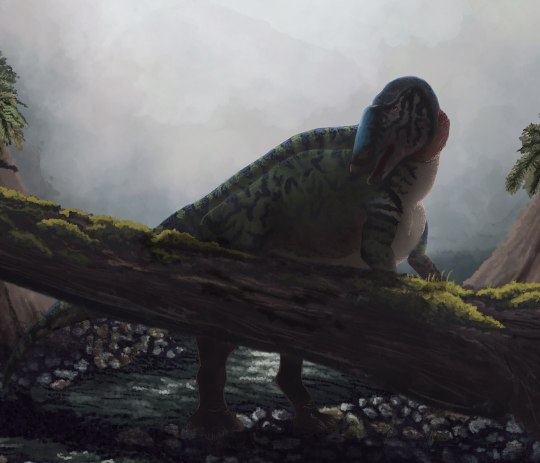#Rocasaurus
Explore tagged Tumblr posts
Text

A fossilized cluster of dinosaur eggshells of an indeterminate titanosaurian sauropod from the Allen Formation near General Roca, Rio Negro, Argentina. While often attributed to Saltasaurus robustus, the genus no longer occurs in this deposit. Many titanosaurs like Bonatitan and Rocasaurus have since been described from the region and it is likely impossible to determine which taxa an egg or eggshell would belong to. This type of eggshell is often referred to the ootaxa Megaloolithus sp. which is often attributed to titanosaurian sauropods. Eggshells labeled as Saltasaurus were once very common in the fossil trade, but has since become increasingly scarce since Argentina's ban on fossils a few decades back.
#dinosaur#fossils#ootaxon#paleontology#palaeontology#paleo#palaeo#megaloolithus#saltasaurus#bonatitan#rocasaurus#aeolosaurus#menucocelsior#panamericansaurus#titanosauriformes#sauropod#cretaceous#mesozoic#prehistoric#science#paleoblr#サルタサウルス#ティタノサウルス形類#恐竜#化石#古生物学
6 notes
·
View notes
Text
Bonapartesaurus, a new Gondwana saurolophine.
Bonapartesaurus, a new Gondwana saurolophine.
Finding new Gondwana hadrosaurs is always an event. I have had the great pleasure and honour to restore this robust new saurolophine for my friend Penélope Cruzado Caballero, that has done her PhD on hadrosaurs!. She has always been the Hadrosaur Ace to my eyes.
Bonapoartesaurus rionegrensis, published in the Journal of Vertebrate Paleontology, possesses a strange mixture for characters that…
View On WordPress
#Aeolosaurus#Argentina#Asturias#Bonapartesaurus#Gondwana#hadrosaurs#José Bonaparte#Penélope Cruzado Caballero#Prosaurolophus#Rocasaurus#Salitral Moreno#Saurolophines#titanosaurs
1 note
·
View note
Text
Stegouros vs Patagopelta


Factfiles:
Stegouros elengassen

Artwork by Luis Enrique Pérez López, written by @zygodactylus
Name Meaning: Armored Creature with a Roofed Tail
Time: 74.9 to 71.7 million years ago (Campanian to Maastrichtian stages of the Late Cretaceous)
Location: Dorotea Formation, Patagonia, Chile
South America is just where the nonavian dinosaur party is happening these days! Stegouros is another recently described species from this continent, and another weird one - it was an Ankylosaur, but not a Nodosaur or an Ankylosaurid, and more to the point, instead of a tail club it had a series of vertebrae enclosed in osteoderms, in a shape that looked a lot like a macuahuitl - the tail was also very short, shorter than any other Thyreophoran, with flattened vertebrae coming together to form the strange and distinctive shape (similar short vertebrae are known from its relative, Antarctopelta). At around 2 meters long, it was very small for an Ankylosaur, though it had a head that was quite large for its body. It also had inward curving teeth, making them look vaguely hourglass-shaped, though they were also asymmetrical. It had many typical ankylosaur traits, but also some stegosaurian ones such as hollow sides to their vertebrae. Overall, it was very similar in proportions and appearance to Antarctopelta, indicating Antarctopelta may have looked more like Stegouros than previously thought. It had limb bones similar to cursorial Ankylosaurs, indicating Stegouros itself was a fast and efficient mover; and it even had claws shaped like hooves which may have enabled even more efficient running and locomotion. So, yeah. A short big headed ankylosaur built for running with a freaking ax on its tail. That’s normal! Living in the Dorotea Formation, Stegouros probably lived near the coast, alongside different sorts of mammals, fish, bivalves, amphibians, plesiosaurs, turtles, and unnamed dinosaurs such as opposite birds, megaraptors, Unenlagiines, and possible titanosaurs.
Patagopelta cristata

Artwork by Gabriel Diaz Yantén, written by @zygodactylus
Name Meaning: Crested Patagonian Shield
Time: 73 to 69 million years ago (Campanian to Maastrichtian stage of the Late Cretaceous)
Location: Allen Formation, Patagonia, Argentina
Patagopelta is another ankylosaur on our roster, a small nodosaur known from the same environment as Kelumapusaura. One of the smallest known ankylosaurs, it was only about 2 meters long, resembling the dwarf nodosaur Struthiosaurus in overall size. It had crested osteoderms along its neck, making it distinctive in armor from its relatives as well. Along with other North American taxa, such as the hadrosaurs, Patagopelta was part of a first experiment in American biotic interchange, as taxa from both continents bled into the other at the very end of the Cretaceous. In the Allen Formation, Patagopelta lived in a coastal environment of fluvial plains, ephemeral lakes, tidal flats, and estuaries with extreme semiarid seasonality. Evaporites would accumulate in the arid seasons, only to be washed away as the wet season returned. Many dinosaurs are known from this formation: Aeolosaurus, Austroraptor, Bonapartesaurus, Bonapartenykus, Bonatitan, Kelumapusaura, Lamarqueavis, Lapampasaurus, Limenavis, Menucocelsior, Niebla, Panamericansaurus, Pellegrinisaurus, Quilmesaurus, Rocasaurus, and Willinakaqe. In addition, Patagopelta shared its home with pterosaurs such as Aerotitan, tuatarans, plesiosaurs, frogs, and a variety of mammals.
DMM Round One Masterpost
#dmm#dinosaur march madness#dmm round one#dmm rising stars#palaeoblr#dinosaurs#paleontology#bracket#march madness#polls#stegouros#patagopelta
128 notes
·
View notes
Text

A dinosaur tooth of an indeterminate titanosaurian sauropod, possibly from the Allen Formation in Patagonia, Argentina. These teeth were previously dumped into the invalid Saltasaurus robustus, but many titanosaurs like Bonatitan and Rocasaurus have since been described from the region. This tooth previously had some restoration at the very tip which was removed.
#dinosaur#fossils#paleontology#palaeontology#paleo#palaeo#saltasaurus#bonatitan#rocasaurus#aeolosaurus#menucocelsior#panamericansaurus#titanosauriformes#sauropod#cretaceous#mesozoic#prehistoric#science#paleoblr#サルタサウルス#ティタノサウルス形類#恐竜#化石#古生物学
11 notes
·
View notes
Text
Kelumapusaura vs Gobihadros


Factfiles:

Artwork by Leonardo HerSan, written by @zygodactylus
Name Meaning: Reptile Shaman of the Red Earth
Time: 73 to 69 million years ago (Campanian to Maastrichtian stages of the Late Cretaceous)
Location: Allen Formation, Patagonia, Argentina
Kelumapusaura is another addition to the growing number of South American hadrosaurs, a radiation of this group that was previously considered unlikely but appears to have happened towards the very end of the Cretaceous period - thus showing that hadrosaurs reached almost every continent, except perhaps Australia! It was an average sized hadrosaur, reaching about 9 meters long, and as a member of the Kritosaurs it probably had enlarged nasal passages for sound production and communication. It would have lived in social groups, like other hadrosaurs. In the Allen Formation, Kelumapusaura lived in a coastal environment of fluvial plains, ephemeral lakes, tidal flats, and estuaries with extreme semiarid seasonality. Evaporites would accumulate in the arid seasons, only to be washed away as the wet season returned. Many dinosaurs are known from this formation: Aeolosaurus, Austroraptor, Bonapartesaurus, Bonapartenykus, Bonatitan, Lamarqueavis, Lapampasaurus, Limenavis, Menucocelsior, Niebla, Panamericansaurus, Patagopelta, Pellegrinisaurus, Quilmesaurus, Rocasaurus, and Willinakaqe. In addition, Kelumapusaura shared its home with pterosaurs such as Aerotitan, tuatarans, plesiosaurs, frogs, and a variety of mammals.
Gobihadros mongoliensis

Artwork by KookaburraSurvivor, written by @zygodactylus
Name Meaning: Hadrosaur from the Gobi of Mongolia
Time: 90 to 86 million years ago (Turonian to Coniacian stages of the Late Cretaceous)
Location: Upper Beds, Bayan Shireh Formation, Bayshin Tsav, Baynshire, Char Teeg, Khongil Tsav, Khoorai Tsav, Mongolia Gobihadros is an early almost-hadrosaur from the Bayan Shireh Formation, one of the rare environments preserving the evolution of dinosaurs during the start of the Late Cretaceous epoch - essentially, when the charismatic dinosaurs of the Latest Cretaceous, such as hadrosaurs, first evolved. Multiple specimens are known from throughout the formation, making Gobihadros the best known early hadrosauroid from Asia. Adults reached sizes of about 7.5 meters long, and it had as many as three teeth per position within the lower jaw (this is high even for early hadrosaurs, more similar to those of later taxa, indicating convergent/parallel evolution). It also still retained the conical thumb claw of earlier ornithopods like Iguanodon. An older individual of the species showed signs of calcium pyrophosphate deposition disease, a condition of age causing restriction in the joints and pain during movement. Gobihadros lived in a semi-arid plain environment littered with lakes and rivers, with meandering bodies of water draining into the sea on the coast of China. Flowering plants were present in this environment, as well as a wide variety of animal life - sharks, Azhdarchids, turtles, and other dinosaurs like Alectrosaurus (probably), a troodontid, Erlikosaurus, Caenagnathoids, Garudimimus, Graciliceratops, a possible Carcharodontosaur (which would be a late surviving species), Talarurus, and potentially many more species waiting to be formally named.
DMM Round One Masterpost
#dmm#dinosaur march madness#dmm round one#dmm rising stars#palaeoblr#dinosaurs#paleontology#bracket#march madness#polls#kelumapusaura#gobihadros
71 notes
·
View notes
Text
Rocasaurus muniozi

Source: http://dinosauriosdeargentina.blogspot.com/2009/03/dinosaurios-de-rio-negro.html
Name: Rocasaurus muniozi
Name Meaning: Roca City Reptile
First Described: 2000
Described By: Salgado & Azpilicueta
Classification: Dinosauria, Saurischia, Eusaurischia, Sauropodomorpha, Plateosauria, Massopoda, Sauropodiformes, Anchisauria, Sauropoda, Gravisauria, Eusauropoda, Neosauropoda, Macronaria, Titanosauriformes, Somphospondyli, Titanosauria, Lithostrotia, Saltasauridae
Rocasaurus is a titanosaur known from - surprise, surprise - the Allen Formation in Rio Negro Province, Argentina. It lived in the Campanian age of the Late Cretaceous, around 75 or so million years ago. It was about 8 meters long, though it could have been larger, since the specimen may be that of a juvenile. It is known from partial remains, and lived alongside Saltasaurus.
Sources:
http://www.prehistoric-wildlife.com/species/r/rocasaurus.html
https://en.wikipedia.org/wiki/Rocasaurus
Shout out goes to @azirigel!
#rocasaurus#rocasaurus muniozi#dinosaur#sauropod#paleontology#prehistory#prehistoric life#dinosaurs#biology#a dinosaur a day#a-dinosaur-a-day#dinosaur of the day#dinosaur-of-the-day#science#nature#factfile#azirigel#डायनासोर#ديناصور#ডাইনোসর#risaeðla#dinozor#ڈایناسور#deinosor#khủng long#Dinosaurier#ไดโนเสาร์#恐龍#恐龙#dinosaure
17 notes
·
View notes